2013 DACIA SANDERO seats
[x] Cancel search: seatsPage 26 of 146
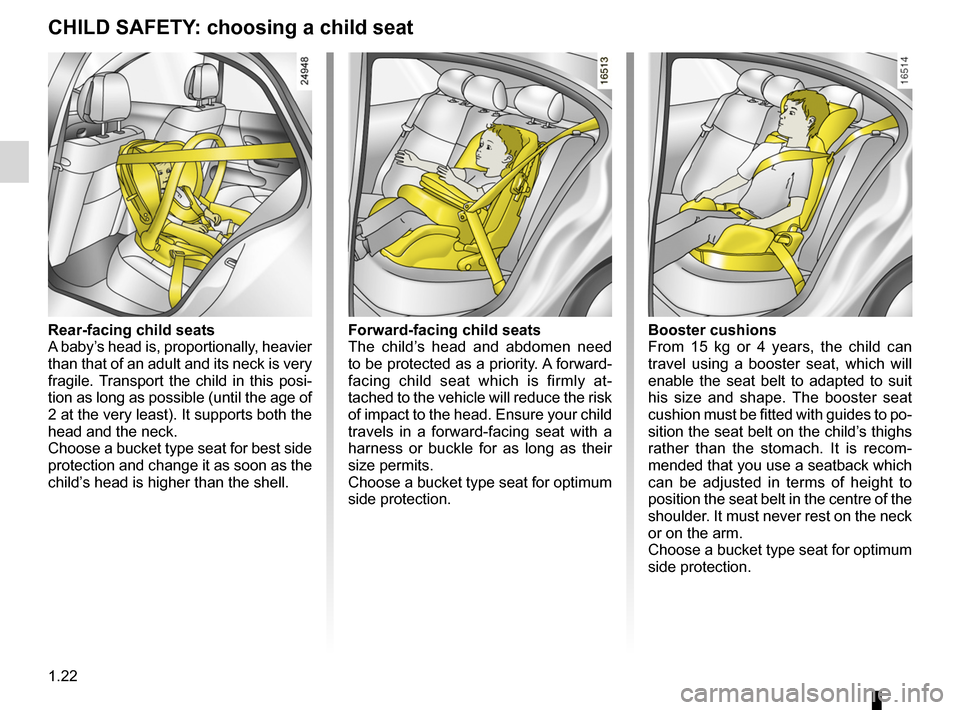
1.22
ENG_UD7556_2Sécurite enfants : généralités (B90 - F90 - R90 - L90 Ph2 -\
Dacia)ENG_NU_817-2_NU_Dacia_1
Booster cushionsFrom 15 kg or 4 years, the child can travel using a booster seat, which will enable the seat belt to adapted to suit his size and shape. The booster seat cushion must be fitted with guides to po- sition the seat belt on the child’s thighs rather than the stomach. It is recom- mended that you use a seatback which can be adjusted in terms of height to position the seat belt in the centre of the shoulder. It must never rest on the neck or on the arm.Choose a bucket type seat for optimum side protection.
Forward-facing child seatsThe child’s head and abdomen need to be protected as a priority. A forward- facing child seat which is firmly at- tached to the vehicle will reduce the risk of impact to the head. Ensure your child travels in a forward-facing seat with a harness or buckle for as long as their size permits.Choose a bucket type seat for optimum side protection.
Rear-facing child seatsA baby’s head is, proportionally, heavier than that of an adult and its neck is very fragile. Transport the child in this posi- tion as long as possible (until the age of 2 at the very least). It supports both the head and the neck.Choose a bucket type seat for best side protection and change it as soon as the child’s head is higher than the shell.
CHILD SAFETY: choosing a child seat
Page 27 of 146

child restraint/seat ................................(up to the end of the DU)child restraint/seat ................................(up to the end of the DU)child restraint/seat ................................(up to the end of the DU)child safety............................................(up to the end of the DU)child seats.............................................(up to the end of the DU)transporting children .............................(up to the end of the DU)
1.23
ENG_UD8388_2Sécurité enfants : choix de la fixation du siège enfant (B90 -\
Dacia)ENG_NU_817-2_NU_Dacia_1
Choosing a child seat mounting
CHILD SAFETY : choosing a child seat mounting
The are two ways of attaching child seats: via the seat belt or using the ISOFIX system.
Attachment via the seat belt
The seat belt must be adjusted to ensure that it is effective in the event of harsh braking or an impact.
Ensure that the strap paths indicated by the child seat manufacturer are re- spected.
Always check that the seat belt is cor- rectly fastened by pulling it up, then pulling it out fully whilst pressing on the child seat.
Check that the seat is correctly held by moving it from side to side and back to front: the seat should remain firmly fixed.
Check that the child seat has not been installed at an angle and that it is not resting against a window.
Attachment with the ISOFIX system
Authorised ISOFIX child seats are ap- proved in accordance with regulation ECE-R44 in one of the three following scenarios:
– ISOFIX universal 3-point forward- facing seat
– ISOFIX semi-universal 2-point seat
– specific
For the latter two, check that your child seat can be installed by consulting the list of compatible vehicles.
Attach the child seat with the ISOFIX locks, if these are provided. The ISOFIX system allows quick, easy, safe fitting.
The ISOFIX system consists of 2 rings.
Before using an ISOFIX
child seat that you pur- chased for another vehicle, check that its installation is authorised. Consult the list of vehi- cles which can be fitted with the seat with the equipment manufacturer.
No modifications may be made to the component parts of the restraint system (belts, ISOFIX and seats and their mountings) originally fitted.
The seat belt must never be twisted or the tension relieved. Never pass the shoulder strap under the arm or behind the back.Check that the seat belt has not been damaged by sharp edges.If the seat belt does not operate nor- mally, it will not protect the child. Consult an approved dealer. Do not use this seat until the seat belt has been repaired.
Do not use the child seat if it may unfasten the seat belt restraining it: the base of the seat must not rest on the buckle and/or catch of the seat belt.
Page 28 of 146
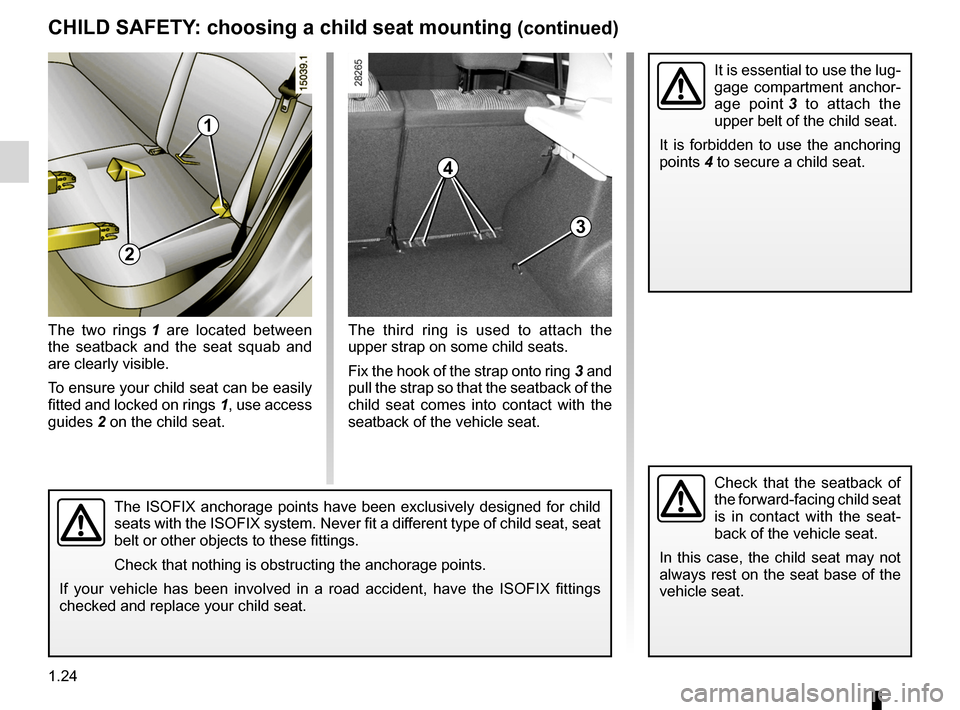
1.24
ENG_UD8388_2Sécurité enfants : choix de la fixation du siège enfant (B90 -\
Dacia)ENG_NU_817-2_NU_Dacia_1
The third ring is used to attach the upper strap on some child seats.
Fix the hook of the strap onto ring
3 and pull the strap so that the seatback of the child seat comes into contact with the seatback of the vehicle seat.
The two rings
1 are located between the seatback and the seat squab and are clearly visible.
To ensure your child seat can be easily
fitted and locked on rings 1, use access
guides 2 on the child seat.
CHILD SAFETY : choosing a child seat mounting (continued)
The ISOFIX anchorage points have been exclusively designed for child seats with the ISOFIX system. Never fit a different type of child seat, seat belt or other objects to these fittings.
Check that nothing is obstructing the anchorage points.
If your vehicle has been involved in a road accident, have the ISOFIX fittings
checked and replace your child seat.
Check that the seatback of
the forward-facing child seat is in contact with the seat- back of the vehicle seat.
In this case, the child seat may not always rest on the seat base of the vehicle seat.
1
2
3
It is essential to use the lug- gage compartment anchor-
age point 3 to attach the upper belt of the child seat.
It is forbidden to use the anchoring
points 4 to secure a child seat.4
Page 29 of 146
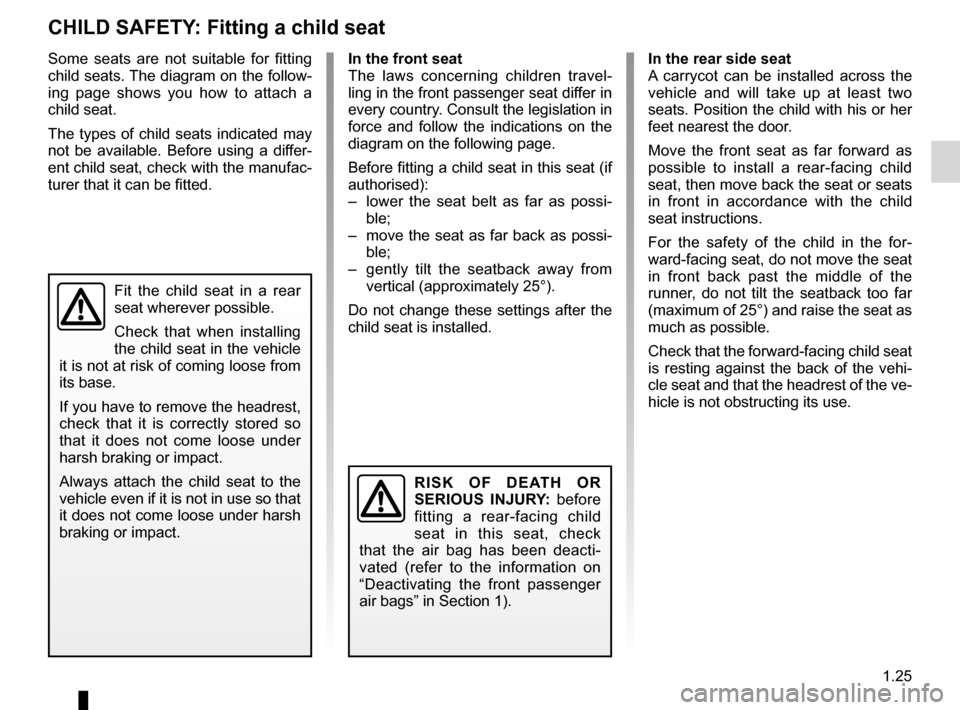
child restraint/seat ................................(up to the end of the DU)child restraint/seat ................................(up to the end of the DU)child restraint/seat ................................(up to the end of the DU)child safety............................................(up to the end of the DU)child seats.............................................(up to the end of the DU)transporting children .............................(up to the end of the DU)
1.25
ENG_UD8389_2Sécurité enfants : installation du siège enfant (B90 - Dacia)\
ENG_NU_817-2_NU_Dacia_1
fitting a child seat
CHILD SAFETY : Fitting a child seat
In the rear side seatA carrycot can be installed across the vehicle and will take up at least two seats. Position the child with his or her feet nearest the door.
Move the front seat as far forward as possible to install a rear-facing child seat, then move back the seat or seats in front in accordance with the child seat instructions.
For the safety of the child in the for- ward-facing seat, do not move the seat in front back past the middle of the runner, do not tilt the seatback too far (maximum of 25°) and raise the seat as much as possible.
Check that the forward-facing child seat is resting against the back of the vehi- cle seat and that the headrest of the ve- hicle is not obstructing its use.
In the front seatThe laws concerning children travel- ling in the front passenger seat differ in every country. Consult the legislation in force and follow the indications on the diagram on the following page.
Before fitting a child seat in this seat (if authorised):
– lower the seat belt as far as possi- ble;
– move the seat as far back as possi- ble;
– gently tilt the seatback away from vertical (approximately 25°).
Do not change these settings after the child seat is installed.
R I S K O F D E AT H O R
SERIOUS INJURY: before fitting a rear-facing child seat in this seat, check that the air bag has been deacti- vated (refer to the information on “Deactivating the front passenger air bags” in Section 1).
Some seats are not suitable for fitting child seats. The diagram on the follow- ing page shows you how to attach a child seat.
The types of child seats indicated may not be available. Before using a differ- ent child seat, check with the manufac- turer that it can be fitted.
Fit the child seat in a rear seat wherever possible.
Check that when installing the child seat in the vehicle it is not at risk of coming loose from its base.
If you have to remove the headrest, check that it is correctly stored so that it does not come loose under harsh braking or impact.
Always attach the child seat to the vehicle even if it is not in use so that it does not come loose under harsh braking or impact.
Page 30 of 146
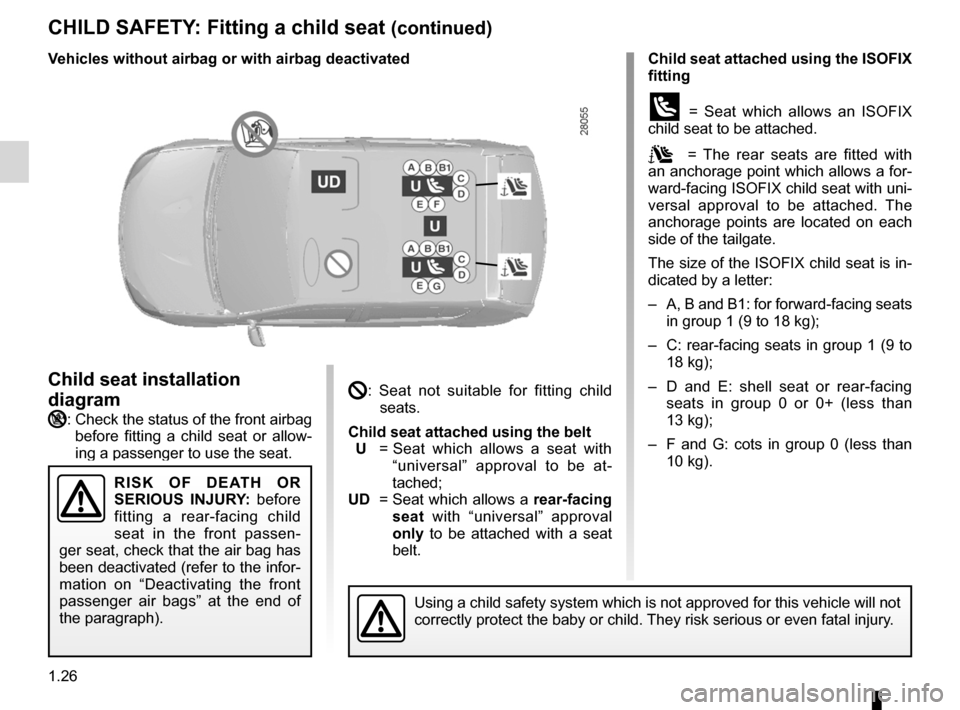
1.26
ENG_UD8389_2Sécurité enfants : installation du siège enfant (B90 - Dacia)\
ENG_NU_817-2_NU_Dacia_1
JauneNoirNoir texte
CHILD SAFETY: Fitting a child seat (continued)
Child seat attached using the ISOFIX fitting
ü = Seat which allows an ISOFIX child seat to be attached.
= The rear seats are fitted with an anchorage point which allows a for- ward-facing ISOFIX child seat with uni- versal approval to be attached. The anchorage points are located on each side of the tailgate.
The size of the ISOFIX child seat is in- dicated by a letter:
– A, B and B1: for forward-facing seats
in group 1 (9 to 18 kg);
– C: rear-facing seats in group 1 (9 to
18 kg);
– D and E: shell seat or rear-facing
seats in group 0 or 0+ (less than
13 kg);
– F and G: cots in group 0 (less than
10 kg).
: Seat not suitable for fitting child seats.
Child seat attached using the belt
U = Seat which allows a seat with “universal” approval to be at- tached;
UD = Seat which allows a rear-facing seat with “universal” approval only to be attached with a seat belt.
Using a child safety system which is not approved for this vehicle will not correctly protect the baby or child. They risk serious or even fatal injury.
Child seat installation
diagram
:
Check the status of the front airbag before fitting a child seat or allow- ing a passenger to use the seat.
R I S K O F D E AT H O R
SERIOUS INJURY: before fitting a rear-facing child seat in the front passen- ger seat, check that the air bag has been deactivated (refer to the infor- mation on “Deactivating the front passenger air bags” at the end of the paragraph).
v ehicles without airbag or with airbag deactivated
Page 31 of 146
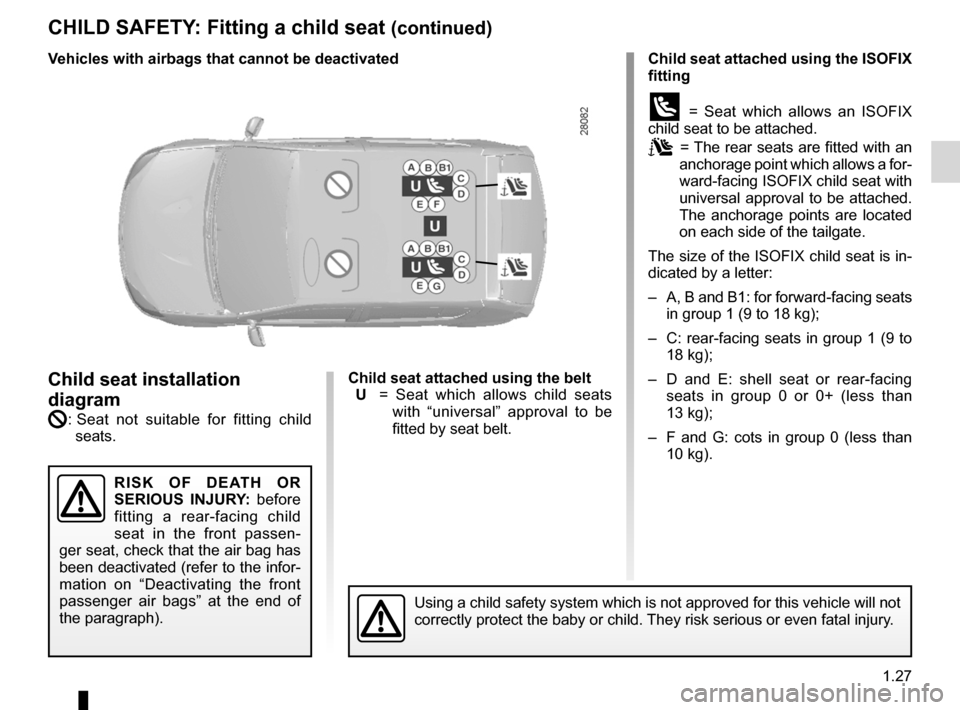
JauneNoirNoir texte
1.27
ENG_UD8389_2Sécurité enfants : installation du siège enfant (B90 - Dacia)\
ENG_NU_817-2_NU_Dacia_1
CHILD SAFETY: Fitting a child seat (continued)
Child seat attached using the ISOFIX fitting
ü = Seat which allows an ISOFIX child seat to be attached.
= The rear seats are fitted with an anchorage point which allows a for- ward-facing ISOFIX child seat with universal approval to be attached. The anchorage points are located on each side of the tailgate.
The size of the ISOFIX child seat is in- dicated by a letter:
– A, B and B1: for forward-facing seats
in group 1 (9 to 18 kg);
– C: rear-facing seats in group 1 (9 to
18 kg);
– D and E: shell seat or rear-facing
seats in group 0 or 0+ (less than
13 kg);
– F and G: cots in group 0 (less than
10 kg).
Child seat attached using the belt
U = Seat which allows child seats with “universal” approval to be fitted by seat belt.
Using a child safety system which is not approved for this vehicle will not correctly protect the baby or child. They risk serious or even fatal injury.
Child seat installation
diagram
: Seat not suitable for fitting child seats.
R I S K O F D E AT H O R
SERIOUS INJURY: before fitting a rear-facing child seat in the front passen- ger seat, check that the air bag has been deactivated (refer to the infor- mation on “Deactivating the front passenger air bags” at the end of the paragraph).
v ehicles with airbags that cannot be deactivated
Page 32 of 146
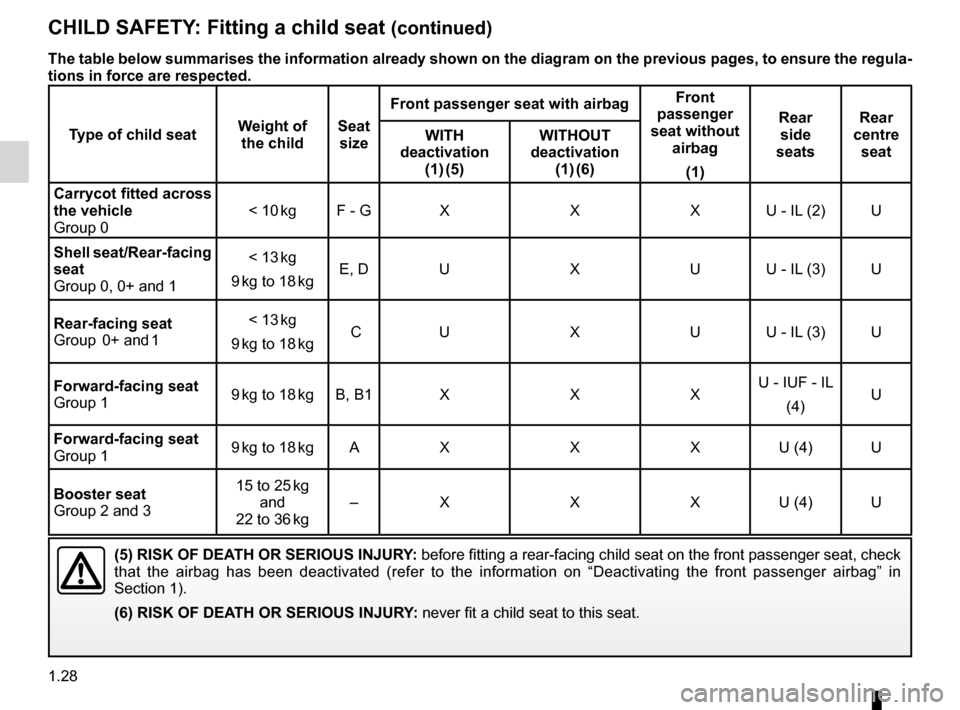
1.28
ENG_UD8389_2Sécurité enfants : installation du siège enfant (B90 - Dacia)\
ENG_NU_817-2_NU_Dacia_1
JauneNoirNoir texte
CHILD SAFETY: Fitting a child seat (continued)
(5) RISK OF DEATH OR SERIOUS INJURY: before fitting a rear-facing child seat on the front passenger seat, check that the airbag has been deactivated (refer to the information on “Deactivating the front passenger airbag” in
Section 1).
(6) RISK OF DEATH OR SERIOUS INJURY: never fit a child seat to this seat.
The table below summarises the information already shown on the diagram on the previous pages, to ensure the regula- tions in force are respected.
Type of child seat w
eight of the childSeat size
Front passenger seat with airbagFront passenger seat without airbag
(1)
Rear side seats
Rear centre seat
wITH deactivation
(1) (5) wITHOUT deactivation
(1) (6)
Carrycot fitted across the vehicleGroup 0< 10 kgF - GXXXU - IL (2)U
Shell seat/Rear-facing seatGroup 0, 0+ and 1
< 13 kg
9 kg to 18 kgE, DUXUU - IL (3)U
Rear-facing seat
Group 0+ and 1< 13 kg
9 kg to 18 kg CUXUU - IL (3)U
Forward-facing seatGroup 19 kg to 18 kgB, B1XXXU - IUF - IL
(4)U
Forward-facing seatGroup 19 kg to 18 kgAXXXU (4)U
Booster seatGroup 2 and 3
15 to 25 kg
and 22 to 36 kg–XXXU (4)U
Page 33 of 146
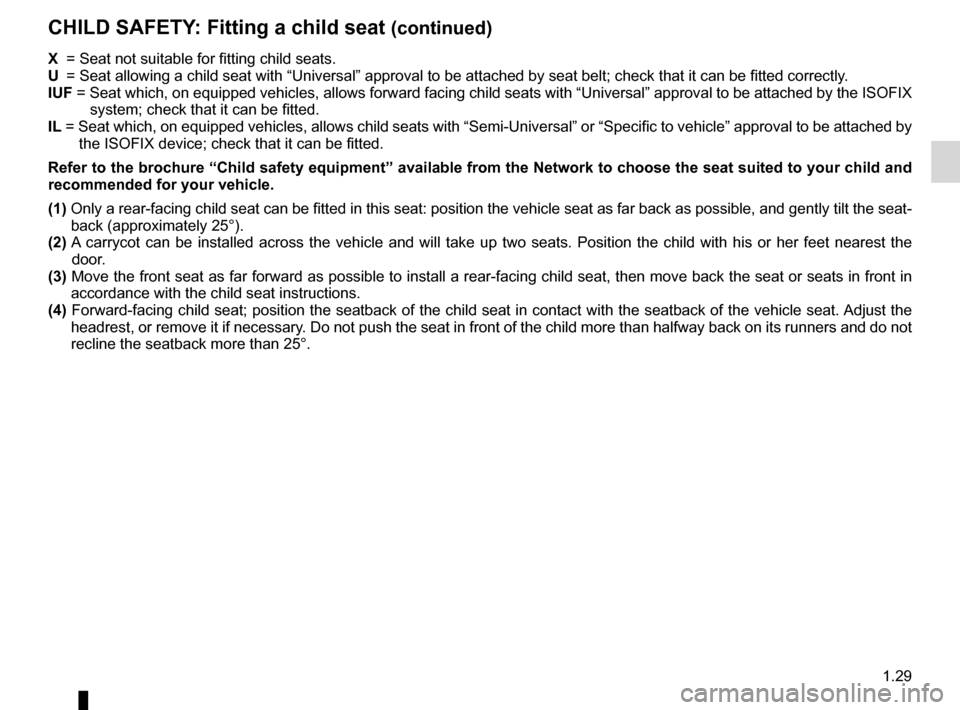
JauneNoirNoir texte
1.29
ENG_UD8389_2Sécurité enfants : installation du siège enfant (B90 - Dacia)\
ENG_NU_817-2_NU_Dacia_1
CHILD SAFETY: Fitting a child seat (continued)
X = Seat not suitable for fitting child seats.
U = Seat allowing a child seat with “Universal” approval to be attached by seat belt; check that it can be fitted correctly.
IUF =
Seat which, on equipped vehicles, allows forward facing child seats with “Universal” approval to be attached by the ISOFIX system; check that it can be fitted.IL =
Seat which, on equipped vehicles, allows child seats with “Semi-Universal” or “Specific to vehicle” approval to be attached by the ISOFIX device; check that it can be fitted.
Refer to the brochure “Child safety equipment” available from the Network to choose the seat suited to your child and recommended for your vehicle.
(1)
Only a rear-facing child seat can be fitted in this seat: position the vehicle seat as far back as possible, and gently tilt the seat- back (approximately 25°).(2)
A carrycot can be installed across the vehicle and will take up two seats. Position the child with his or her feet nearest the door.
(3)
Move the front seat as far forward as possible to install a rear-facing child seat, then move back the seat or seats in front in accordance with the child seat instructions.(4)
Forward-facing child seat; position the seatback of the child seat in contact with the seatback of the vehicle seat. Adjust the headrest, or remove it if necessary. Do not push the seat in front of the child more than halfway back on its runners and do not recline the seatback more than 25°.